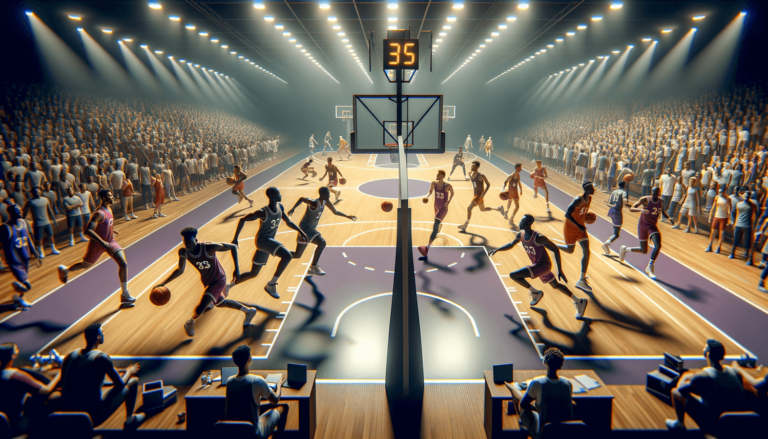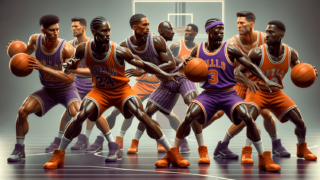
Picture this: an arena filled with talented basketball players showcasing their skills, college coaches, and NBA scouts meticulously evaluating every move, and behind-the-scenes interviews full of raw determination and passion. If this has you on the edge of your seat, then welcome to the fascinating world of basketball combines! In this enthralling blog post, we will explore how these extraordinary events bring the best athletes under one roof, all with the sole purpose of proving their mettle on the court, and how they can substantially influence these players’ careers. So, lace up those sneakers and join us as we dive deep into the heart-pounding excitement of the Basketball Combine!
What’s a Basketball Combine?
A basketball combine is a structured event where individual players have the opportunity to showcase their skills, athletic abilities, and mental prowess in front of scouts, coaches, and team representatives. During the combine, players participate in various physical tests, on-court drills, and interviews to demonstrate their potential to succeed at a higher level. It serves as a talent evaluation platform for leagues like the NBA, collegiate programs, and other professional associations to find and draft the finest players to their respective teams.
A Deep Dive into Basketball Combines
Now that we know what a basketball combine is, let’s dive deeper into its various aspects that make it an essential step in a player’s journey to the top of the sport, aptly described as “the ultimate dream.” While covering the minute details of every component might be arduous, we’ll give an overview of the key ingredients that spice up the basketball combine experience.
Physical Assessments
One of the crucial elements in a basketball combine is the physical assessments. These tests are designed to evaluate the raw physical attributes of the athletes, such as their strength, agility, speed, and stamina. Let’s take a look at some of the most prevalent assessments conducted during a combine:
Body Measurements
Measuring basketball players’ height, wingspan, and standing reach gives a sneak peek into their advantages and limitations on the court. For instance, a long wingspan can greatly influence a player’s ability to block shots and deflect passes. The same applies to their standing reach, which can turn them into a lethal threat in terms of rebounds and interior defense.
Vertical Jump
The ability to leap skyward is an invaluable skill in basketball. No wonder the Vertical Jump test is a combine staple. It measures a player’s potential to elevate, reflecting their explosiveness and capacity to compete for rebounds, blocks, and dunks. Athletes are typically tested for both standing vertical jump (minimal run-up allowed) and maximum vertical jump (with a full run-up).
Bench Press
Bench press tests measure upper body strength, which is vital for a basketball player’s overall game. Be it posting up against a defender, holding off an opponent for a rebound, or resisting aggressive drives, the importance of upper body strength cannot be underestimated in basketball.
Agility Testing: Lane Agility Drill and Shuttle Run
Agility is essential for actions like sudden lateral movements, defensive positioning, and overall quickness during a game. The Lane Agility Drill measures a player’s ability to move swiftly in various directions. The Shuttle Run, on the other hand, focuses specifically on lateral movements and first-step quickness.
Sprint Test
The ability to outrun your opponent can often be the key to steal a loose ball for a decisive fast break. The Sprint Test measures a basketball player’s straight-line speed by having them complete a predefined distance, usually 25-30 meters, as quickly as possible.
On-Court Drills
The physical assessments only provide part of the picture of a player’s abilities. To evaluate the more concrete aspects of a player’s skillset, the combines showcase various on-court drills that cater to every position and role on a basketball team.
Shooting Drills
Although catch-and-shoot and off-the-dribble shooting drills are the most common during a combine, an array of other shooting tests can also be included. Among them are mid-range jump shots, three-point shooting, and spot-up shooting tests. These drills help coaches and scouts gauge a player’s shooting form, consistency, accuracy, and range.
One-on-One Games
Since basketball brings together athleticism and skill, competing against another player head-to-head is a great way to test an athlete’s overall abilities. One-on-one games allow players to demonstrate offensive moves and defensive prowess, proving valuable when it comes to evaluating decision-making, shot creation, and the ability to adapt to an opponent.
Full-Court Drills and Games
Full-court drills or even five-on-five games are vital components of a combine, as they offer a glimpse into a player’s understanding of the game, teamwork, and communication skills. Running fast breaks, setting up plays, and executing offensive and defensive strategies all come into focus during these types of basketball activities.
Off-Court Evaluations
Superior physical capability and on-court skills are not the sole requisites of a complete basketball player. Coaches and scouts place significant value on the intangible, off-court qualities that an athlete possesses. Let’s consider some key off-court evaluations performed during a basketball combine:
Interviews
Interviews during a basketball combine help assess a player’s mindset, motivations, background, and aspirations. They delve deeper into personal and professional experiences that may have influenced their careers thus far. Scouts and coaches aim to understand how these factors will play a role in a player’s development and success at the professional level.
Psychometric Testing
Psychometric tests further enhance the off-court evaluation process by examining intelligence, personality traits, and behavioral tendencies that could impact an athlete’s performance in high-pressure situations. The collected data can provide valuable insights into the player’s ability to handle stress, problem-solving capacity, and adaptability on and off the court.
The Impact and Importance of Basketball Combines
All these assessments and drills come together under the basketball combine umbrella to create the ultimate platform for evaluating players. They are a significant part of the process, so let’s take a look at some of the ways these events shape a player’s career:
NBA Draft Connection
One of the most significant basketball combines worldwide is the NBA Draft Combine. It features a select group of college and international prospects who showcase their skills and undergo rigorous testing for a chance to be drafted by an NBA team. Their performances during the combine can impact their draft stock substantially, with some players skyrocketing up the draft boards and others dropping due to disappointing showings.
Discovering Diamonds in the Rough
A basketball combine can help identify untapped talent that might otherwise slip under the radar. Hidden gems or late bloomers can excel in the structured environment, generating interest from scouts and coaches who may have initially dismissed them due to lack of exposure or visibility.
Collegiate and Overseas Opportunities
Basketball combines are not only limited to the NBA but are also accessible to college and international teams. These events cater to a wide variety of prospective players aiming to secure athletic scholarships, climb the collegiate ranks, or even kickstart their professional careers abroad.
Networking and Exposure
Apart from the actual evaluation, basketball combines offer players the chance to meet and network with coaches, scouts, and key decision-makers in various professional organizations. Building relationships at these events could prove crucial for future opportunities in the sport.
Preparing for a Basketball Combine
Succeeding at a basketball combine takes meticulous preparation, discipline, and determination. Athletes must be ready mentally and physically before attending one of these events. Here are some tips on how to approach combine preparation:
Establish a Focused Training Regimen
It’s essential to maintain a purposeful training regimen that involves basketball-specific conditioning, strength training, and daily skill development sessions. By doing so, athletes will be better equipped to perform optimally during the array of assessments and drills at a combine.
Seek Professional Guidance
Working with experienced coaches or trainers can help fine-tune an athlete’s preparation process. They can provide valuable input on areas for improvement and supply personalized workouts tailored to an individual’s strengths and weaknesses. This guidance aids in amplifying the possible outcomes of the participant’s performance during a basketball combine.
Mental Preparation
Basketball combines test an athlete’s mental fortitude as much as their physical prowess. Developing a strong mindset, meditating, channeling focus, and building up self-belief all contribute to the ability to perform under pressure. The significance of mental preparedness should not be overlooked.
As we’ve learned, basketball combines are a gateway into a world of opportunities for aspiring players. Excelling at these enigmatic events can unlock the door to unimaginable successes, giving athletes a platform to embark on their dream basketball journey.
A Glimpse into Famous Basketball Combines
Now that we have a deeper understanding of the ins and outs of a basketball combine, let’s briefly explore some of the prominent events around the globe. Each of these combines has its own unique approach, but all aim to empower athletes in furthering their basketball careers.
NBA Draft Combine
The gold standard of basketball combines, the NBA Draft Combine, is an annual event that gathers the most promising college and international prospects before the NBA Draft. The combine’s primary function is to evaluate players, but it also offers an opportunity for prospects to network with NBA teams, gather feedback on their game, and potentially improve their draft stock. Standout performances at the combine have historical precedence, with players like Kawhi Leonard and Alec Burks propelling into the lottery and first round, respectively.
Portsmouth Invitational Tournament (PIT)
The PIT has been a stepping stone for NBA hopefuls since 1953. This four-day event held annually in Portsmouth, Virginia, brings together 64 of the nation’s best college seniors to showcase their skills in a single-elimination tournament format. The PIT provides these players an environment to impress NBA scouts and general managers who are searching for talent that can develop into essential role players or fit specific needs on their rosters.
Adidas Eurocamp
The Adidas Eurocamp is Europe’s premier pre-draft showcase and training camp. This three-day event in Treviso, Italy, has helped launch numerous international players into the NBA, such as Danilo Gallinari and Serge Ibaka. Eurocamp offers an ideal blend of skill development, evaluation, and competition, enabling the players to put their best foot forward in front of scouts from NBA, NCAA, and global professional clubs.
Post-Combine Success Strategies
Participating in a basketball combine is only one aspect of the equation when striving for a professional career. Following up after the event, remaining proactive, and seizing opportunities are equally critical. Here are a few post-combine strategies that help players stay on track:
Analyze and Implement Feedback
One of the most valuable takeaways from a basketball combine is the feedback from coaches, scouts, and trainers. It’s essential to analyze this information, identify shortcomings, and create an action plan to address these weaknesses to continue developing as a player. Implementing this feedback can lead to substantial improvements and open new doors for future opportunities.
Maintain Communication
In the aftermath of a combine, it’s crucial to stay in touch with the connections made during the event. Regularly updating scouts, coaches, or team representatives on your progress and achievements demonstrates a strong commitment to the sport and may entice them to consider you for future opportunities.
Join Camps and Training Programs
To keep the momentum going after a combine, athletes should aim to participate in additional camps, showcases, and elite training programs to continually challenge themselves and learn from a variety of coaching styles. Exposure to various settings keeps players fine-tuned, preparing them for a wide array of situations on and off the court.
In conclusion, basketball combines are an integral part of a player’s journey towards a professional career, offering exposure, development, and opportunities all in one package. Success at these events can turn an athlete’s aspirations into a reality, but perseverance and dedication post-combine are pivotal to sustaining that success. Stay committed, embrace your basketball dreams, and you might just be the next on-court sensation!
FAQ: Everything You Want to Know about Basketball Combines
Looking for answers to some of your burning questions about basketball combines? We’ve got you covered! Here’s a compilation of frequently asked questions related to these exciting events. Dive in to deepen your understanding and gain valuable insights into the basketball combine scene.
What are the age restrictions for basketball combines?
Age restrictions may vary depending on the specific combine. For events like the NBA Draft Combine, participants are typically college-aged or early career professional players. However, there are also high-school level combines targeting younger prospects. It’s important to research and identify the age and skill requirements for each combine to find the one that fits your profile.
How do I apply for a basketball combine?
To apply for a basketball combine, begin by researching various events and identifying the ones suited to your skill level and career goals. Combines may require an online application or an invitation through a coach or an athletic program. Keep an eye on combine registration dates and closely follow event-specific application processes.
Are there fees associated with participating in a combine?
Yes, basketball combines often require registration or participation fees to cover the costs of organizing the event, renting facilities, and providing various resources. However, the fees may vary depending on the scale, duration, and level of the combine. Make sure to factor in these financial aspects when researching and applying for events.
How can I best prepare for a basketball combine?
Optimal preparation for a basketball combine involves dedicated training, mental conditioning, and seeking professional guidance. Establish a focused training regimen that addresses basketball-specific conditioning, strength training, and skill development. Additionally, work on building mental strength and resiliency, and consider collaborating with experienced coaches or trainers for personalized guidance and advice.
What should I bring to a basketball combine?
When packing for a basketball combine, remember to bring your basketball gear, including appropriate shoes, athletic wear, a water bottle, and any necessary personal equipment like ankle braces or mouthguards. It’s also a good idea to carry a small notebook and pen to jot down vital feedback and other important information you may receive during the event.
Will I receive feedback on my performance at the combine?
Yes, coaches, trainers, and scouts at combines typically provide feedback to players regarding their skills, strengths, and weaknesses. Always be prepared to ask questions and receive constructive criticism that can help you improve your game, identify areas of growth, and elevate your basketball career.
Does every basketball combine guarantee exposure to professional teams?
The level of exposure to professional teams may vary depending on the specific combine. While larger-scale events, like the NBA Draft Combine, are designed to provide direct exposure, smaller combines may focus more on skill development and personal growth. The key is to identify and attend a variety of combines that suit your goals and allow you to build connections with important basketball stakeholders, including coaches and scouts.
What if I don’t perform well at a basketball combine?
If you don’t perform well at a basketball combine, don’t be too hard on yourself. It’s an opportunity to learn and grow as a player. Take the constructive feedback you receive, analyze your performance, and work on areas that need improvement. Stay persistent, and use the experience to fuel your fire for future basketball endeavors, including skills camps or upcoming combines.
Are basketball combines only for NBA prospects?
No, basketball combines cater to players at various skill levels and career stages. While the NBA Draft Combine is the most well-known event, there are numerous combines targeted at high school, college, and international players who may be seeking to enhance their skills, gain exposure, or join a professional team abroad.
How can I use the experience I gain from a basketball combine to leverage my career?
Attending a basketball combine is a significant growth opportunity for your career. Remember to stay proactive post-combine by analyzing and implementing feedback, building connections with coaches and scouts, and participating in additional camps and training programs. The key is to continually adapt, overcome challenges, and ultimately, become the best basketball player you can be.
Featured Posts
- No pillar pages found.





